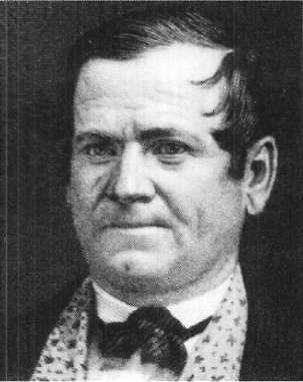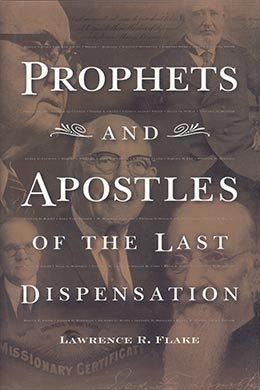Orson Hyde
Lawrence R. Flake, Prophets and Apostles of the Last Dispensation (Provo, UT: Religious Studies Center, Brigham Young University, 2001), 329–32.

Born: 8 January 1805, New Haven, Connecticut
Quorum of the Twelve Apostles: 15 February 1835 (age 30)
Released from the Quorum of the Twelve Apostles: 4 May 1839
Restored to the Quorum of the Twelve Apostles: 27 June 1839
President of the Quorum of the Twelve: 27 December 1847 (seniority reordered)
Quorum of the Twelve Apostles: 10 April 1875
Died: 28 November 1878 (age 73), Spring City, Utah
Traveling seemed to be a chief occupation for Orson Hyde from his youth throughout his entire life. As a lad of fourteen, he walked six hundred miles with a knapsack on his back to a farm purchased by his foster father, Nathan Wheeler, in Kirtland, Ohio. His own father had died when he was seven, and he and his brothers and sisters had been scattered about in various homes. In Ohio, at the age of eighteen, he struck out on his own, pursuing various occupations from iron founder to wool carder in the firm of Newel K. Whitney and A. S. Gilbert, who later became fellow members of the Church.
In 1827 a religious revival that was in the area converted Orson to Methodism. Zealous in his newly found faith, he began a program of self-education in preparation for the ministry. Then a movement headed by Sidney Rigdon and the Campbellites swept the region, and young Mr. Hyde joined that denomination. Continuing to educate himself, he helped to organize churches in and around Mentor, Ohio, which was then his home.
While Orson was serving as pastor for these churches, Parley P. Pratt and his companions came announcing the advent of the Book of Mormon and the restored Church. Believing this “gold Bible” to be a complete hoax, Hyde was preaching against it one day. Suddenly his conscience began to prick him sorely. He resolved to investigate the book further, and as a consequence he joined the Church in 1830.
Orson’s travels then commenced in earnest. He first preached in the area of his former churches. Soon afterward he was called on an extensive mission to the East with the Prophet’s younger brother Samuel as his companion. He made several trips to Missouri, one of them as a member of the historic Zion’s Camp. Upon his return to Kirtland, Orson married Marinda N. Johnson and was ordained in 1835 to the original Quorum of the Twelve Apostles in this dispensation. As an apostle, he made many more missionary journeys, among which was the highly successful 1837 mission of members of the Twelve to England, in which they converted nearly two thousand people in a very short time.
Returning to Far West, Missouri, Brother Hyde became seriously ill. In his physically weakened condition, this devoted apostle became involved with the apostate former president of the Twelve, Thomas B. Marsh, in stirring up persecution against the Church. As a result, Brother Hyde was dropped from membership in the Quorum of the Twelve. Fortunately he soon realized his error, humbly sought forgiveness, and was restored to his former position. For twenty-seven years Elder Hyde served as president of the Twelve, but in 1875 President Brigham Young reordered the seniority of the Quorum, placing Orson Hyde behind those who had been called while he was temporarily out of the Quorum. This made John Taylor the president of the Twelve and successor to Brigham Young. [1]
While living in Nauvoo, Orson saw in a vision that he would fill a mission in Palestine. He saw himself on the Mount of Olives constructing an altar. Shortly after this manifestation, the Prophet Joseph Smith sent him to Palestine to dedicate that land for the return of the scattered tribe of Judah. Traveling alone, under great hardship without purse or scrip, Brother Hyde arrived in the Holy Land where, on Sunday, 24 October 1841, he gave an inspired prayer on the Mount of Olives. Here, as well as on Mt. Zion, he constructed a stone altar according to what he had seen in the vision.
When the Saints began migrating to the Salt Lake Valley, Elder Hyde established a home in Council Bluffs. He stayed at this launching point for several years in order to help the Saints on their way to the West, and he published a newspaper on behalf of the Church called the Frontier Guardian. In 1852 he took his family to Salt Lake and eight years later was assigned to preside over the settlement in Sanpete County, where he performed great spiritual and temporal services for the Saints, including taking a leading role in the building of the Manti Temple. He had a large and faithful family. Orson F. Whitney commented on Brother Hyde’s character in these words: “[He] possessed many excellent qualities, among which were his humility and that indomitable pluck and perseverance by which he overcame the obstacles of poverty and frontier environment, and made himself an educated man, fitted for the prominent place and weighty responsibilities assigned to him.” [2]
Notes
[1] Howard H. Barron, Orson Hyde: Missionary, Apostle, Colonizer (Bountiful, UT: Horizon, 1977), 245–46; “Orson Hyde: Olive Branch of Israel,” New Era, April 1979, 12–15.
[2] Orson F. Whitney, History of Utah (Salt Lake City: Geo. Q. Cannon & Sons, 1892), 4:137. See also Matthias F. Cowley, Prophets and Patriarchs of the Church of Jesus Christ of Latter-day Saints (Chattanooga, TN: Ben E. Rich, 1902), 229–37.
